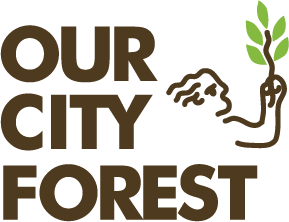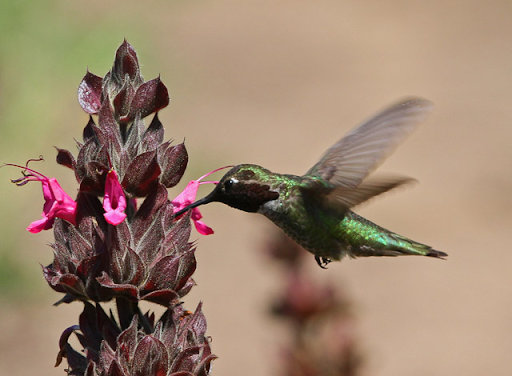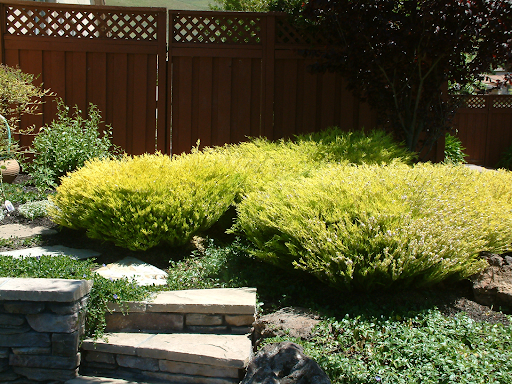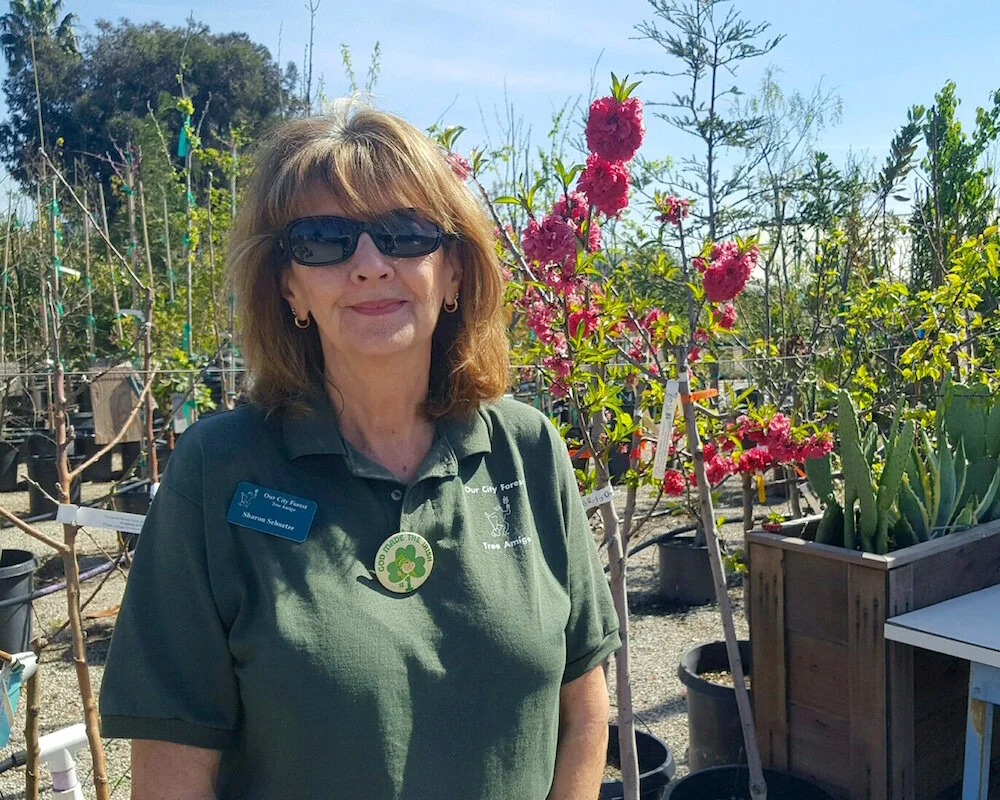Here at Our City Forest (OCF) we love all kinds of plants. But those of us on the Lawn Busters team especially love shrubs. Our Community Nursery has tons of drought-tolerant and California native shrubs that can be used for lawn conversions. Today on the blog we will learn about a select few of them: some aromatic shrubs that smell heavenly and have some cool history behind them! And, you can cook with most of these too!
Artemisia Californica. Common name: California sagebrush.
While this plant is called “sagebrush” it is not actually a true sage. In fact, it is in the Asteraceae, or daisy, family. It can grow up to approximately 4 ft wide and 4 ft tall. This shrub is native to California and exists across western North America, as it belongs in a coastal habitat. It can easily be spotted whilst hiking right here in the Silicon Valley! The stems are thin, with needle-like but supple leaves. The leaves are a lovely silvery-green color, up to 4 inches long, and pinnately arranged. According to the USDA online plant guide, California Sagebrush was used by indigenous people for numerous medicinal purposes, such as toothaches, asthma treatment, menstrual pains, to ease childbirth, and for bathing in when one had a cold or cough. Additionally, it is historically known as “Cowboys’ Cologne” because cowboys used to ride through large amounts of it on their journeys, brush up against it, and come home smelling of it.
Lavadula. This is a lavender plant! The genus lavandula has 47 species within it. At the OCF Community Nursery we have three of these species: French (dentata), English (angustifolia), and Spanish (stoechas ‘anouk’). They all belong to the family Lamiacea, which is the mint and sage family. Depending on the exact species this plant varies from 1-3 ft tall and 1-3 ft wide. It is native to the Mediterranean. Lavender has been used historically for thousands of years, and for an immense number of purposes. In ancient Egypt, it was used in the mummification process. It has also been claimed to be a romance charm, as noted in stories involving Cleopatra and other famous faces. In Ancient Rome it was used to scent bathhouses, and in Elizabethan times it freshly scented clothes and bedding as bathing was not a daily thing yet. It was often used for and associated with cleanliness, the very name “lavender” comes from the Latin verb lavare which means “to wash”. Even today, it is still utilized as a scent for many household products such as laundry detergent. In addition, lavender is said to be very soothing. It has traditionally been dubbed a treatment for insomnia, headaches, hyperactivity, sore joints, toothaches, and to ward off disease. Currently it is popular in essential oil form to diffuse, also with the goal of promoting sleep and calm. The enchanting tales and quirky anecdotes involving lavender go on and on, but one thing we can all agree on is that it smells absolutely divine!
Rosmarinus officinalis aka Salvia rosmarinus (the name was changed in 2017). At our Community Nursery we have two different cultivars, ‘prostratus’ which is the creeping kind as well as ‘tuscan blue’ which is upright. This plant is also from the Lamiaceae family. It is native to the Mediterranean, Portugal, Northwest Spain, and Asia and likes to grow in dry scrub and rocky places, especially near the sea. This plant is woody, evergreen, and has needle-like leaves that are long and narrow with dense, short, woolly hair. It has flowers that are often a pale blue color - but can also be white, pink, purple, or deep blue. These flowers bloom in the springtime, but bloom time can vary a bit based on the exact climate the plant resides in. Sometimes it will bloom as late as November, or as early as February. Pollinators very much like the creeping kind, but will be attracted to either. In terms of size, the upright forms can reach 1.5 m (5 ft) tall, while the creeping kind can get up to 6 ft wide! Something quite interesting about rosemary is that the seeds have a low germination rate and growth is relatively slow, but rosmarinus can live as long as 30 years. Rosemary was used all the way back in 500 BC, for culinary and medicinal purposes by both the Greeks and Romans. It has also been used by various other cultures to treat headaches for centuries. During the Middle Ages, it was thought to have the power to dispel negativity, as such it was tucked under pillowcases to ward off bad dreams and used to cleanse sacred spaces by burning it. It is even being studied right now for its potential anti-cancer effects and the ability to treat Alzheimers.
Salvia. This is a sage plant. The genus salvia contains nearly 1,000 species! All sage is aromatic to varying degrees. At our Community Nursery we have many species of sage: ‘Frankie Lee’, apiana, brandegeei, leucophylla, clevelandii, mellifera, microphylla, officinalis (a culinary sage), spathacea, and uliginosa. We even have multiple cultivars of some of these species available, so there are about 14 to choose from at OCF! Sage is also of the family Lamiaceae. Much like the other plants in this family, salvia has been around for a long time and is historically praised for its medicinal and culinary benefits. It is closely linked to indigenous tribes; as food, medicine, in spiritual practice (ie. the psychoactive salvia divinorum), and for smudging (ie. white sage, salvia apiana). Personally I really like the scent of Salvia spathacea, which is commonly known as Hummingbird Sage. As the name implies, hummingbirds really like this one too! This particular sage grows up to 2 ft tall and 3 ft wide; however, other species can be much larger, reaching up to 10 ft tall and 15 ft wide. The Hummingbird Sage is native and endemic to California. It prefers low elevations near the coast.
Tulbaghia violacea, commonly known as Society Garlic. Our nursery has a regular version and a variegated version, distinguished under the cultivar name ‘silver lace’. The term “variegation” refers to color zonation in the leaves of this plant. As the name suggests, they are lighter and a more silvery-green compared to their counterpart. This shrub belongs to the family Amaryllidaceae, often referred to as the Amaryllis family. It is native to Southern Africa. Society Garlic can grow up to 2 ft tall and 2 ft wide. The flowers are a lovely lilac-pink color when in bloom. The leaves are very thin and long, similar to a grass. This wild garlic has similar antibacterial and antifungal effects of traditional garlic, and likewise is good for the digestive system. Recently it was discovered to have potential anti-cancer properties in vitro, and it is said to be a treatment for throat cancer. The Zulu people who reside in the plants' native South Africa are said to use the leaves/flowers as a food seasoning, the bulb as an aphrodisiac, and to plant it around their homes as a snake-repellent.
Coleonema pulchellum ‘Sunset Gold’ aka Golden Breath of Heaven. It is from the family Rutaceae, commonly known as the Rue or Citrus family. An evergreen shrub that grows up to 2 ft tall and 6 ft wide. It has tiny pink flowers when in bloom and soft needle-like foliage. This plant is originally from South Africa, and prefers climates that are warm and arid with some rainfall in the winter season. An interesting anecdote, Coleonema comes from the Greek word koleos which means 'a sheath', and nema meaning 'a thread or filament'. Pulchellum represents 'pretty' in Latin. So it is basically a ‘pretty needle holder’. Essential oils can be extracted from the plant and used as a bug repellent.






























